Weekly S&P 500 ChartStorm - Downgrades, Dividends, Buybacks
by Topdown ChartsSummary
- This week we take stock of the uneasy landscape with downgrades, delayed payments, and yet massive monetary easing.
- We also document a couple of key trends in dividend land; such as dividend cuts, dividend yield attractiveness, buybacks, and REITs.
- Lastly we look at the push into passive and the associated risks and opportunities, and how this all ties into the market outlook.
Those that follow my personal account on Twitter will be familiar with my weekly S&P 500 #ChartStorm in which I pick out 10 charts on the S&P 500 to tweet. Typically, I'll pick a couple of themes to explore with the charts, but sometimes it's just a selection of charts that will add to your perspective and help inform your own view - whether it's bearish, bullish, or something else!
The purpose of this note is to add some extra context and color. It's worth noting that the aim of the #ChartStorm isn't necessarily to arrive at a certain view but to highlight charts and themes worth paying attention to. But inevitably if you keep an eye on the charts they tend to help tell the story, as you will see below.
So here's another S&P 500 #ChartStorm write-up.
1. Earnings revisions. @TihoBrkan brings us this 25-year look at the S&P 500 and analyst earnings revisions. COVID-19 has led Wall Street analysts to drastically reduce EPS forecasts for the coming quarters as businesses scuffle to salvage the rest of 2020. Intuitively, one would think that a huge uptick in negative earnings outlooks would correspond to a declining stock market, but that has not been the case.
Keep in mind that price is often among the most leading indicators while analysts are known to suffer from conservativism bias – being slow to update their opinions (hence analyst forecasts are a lagging indicator). Market declines came before economic losses. In that sense, earnings revisions are more of a contrarian indicator.
Bottom line: When it comes to cycle data, often times it ends up that good is bad and bad is good. It’s typically during the upswing in the business cycle and in the later stages of the market cycle when the upgrades occur.
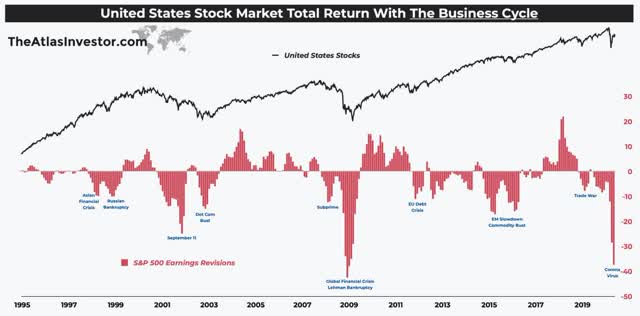
2. Your check is in the mail. Companies are taking longer to pay each other – as depicted in this chart from @athomasq. Abraham Thomas of Quandl shows that business-to-business payments are more than 2 standard deviations below the mean; companies are very slow to pay their debts right now. The index is actually far worse than it was in 2009.
We can also see this trend when looking at bank lending standards data – financial institutions are hesitant around issuing loans right now. Not everyone is able to take advantage of historically low interest rates. The cash conversion cycle (you remember this from business school, right?) is being extended to uncomfortably long periods for some firms.
Bottom line: This is a concerning chart and it highlights one of the key downside risks; i.e., that a liquidity crisis turns into a solvency crisis. Just in time cash flow management is incredibly vulnerable in this environment.
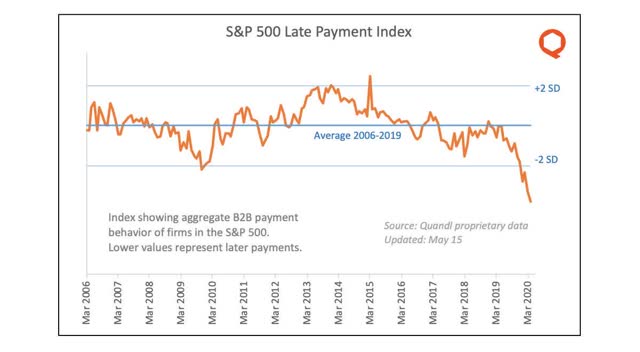
3. Don’t fight the Fed. The Federal Reserve of the United States has aggressively increased their balance sheet by purchasing Treasury securities. A refrain we as traders are used to hearing by now. Analyzing Fed open market operations is a necessary endeavor for macro analysts – you can hate it and disagree with it if you wish, but it’s the way of the economic world.
@meremortenlund provides this dual-axis chart of the S&P 500 year-over-year change [LHS] and the Fed’s Treasury holdings as a percent of outstanding marketable debt [RHS]. You’ll notice a pattern of y/y Treasury holding increases to increases in stock performance. The Fed has been hard at work in 2020 as the y/y increase has been massive.
An interesting feature of this chart is while we think of Fed bond buying activity as propelling the stock market, it’s not always the case. Bernanke was in his helicopter in 2011, but that year was a dud for the equities.
Bottom line: Powell has seemingly outdone Bernanke with monetary stimulus. The S&P 500 has already increased more than 30% from the low just two months ago. Is the Fed done? Do they have bullets for a second wave?
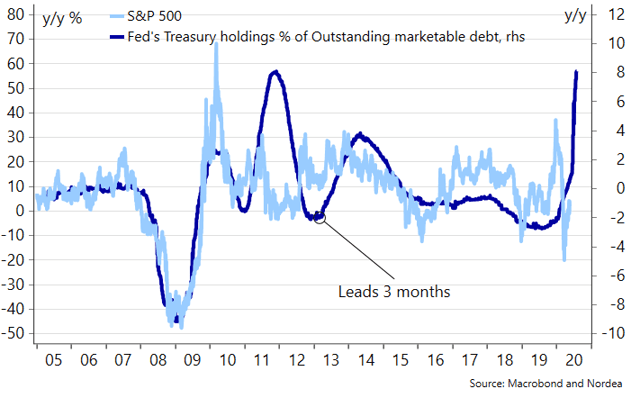
4. Buybacks ain’t what they used to be. Fidelity Investments’ Director of Global Macro Research Jurrien Timmer @TimmerFidelity brings us this look at announced share buybacks. 2020 is tracking among the weaker recent years for announced share repurchases – not surprising given the unexpected economic shutdown we have all experienced. Companies are looking to shore up their balance sheets, and among the activities that requires is often to increase liquidity positions.
A common tactic from the last several years in a world with cheap credit was to issue debt and buy back stock – this strategy can actually reduce a firm’s overall cost of capital since debt is typically much more inexpensive than equity.
The risk is that the firm grows more leveraged, so any hiccups in the business environment could be perilous for solvency. Sure enough, COVID-19 and its economic ramifications struck. So corporations are now reluctant to announce share buybacks for two reasons: 1) it increases leverage during these uncertain times and 2) the optics are bad – how many articles have we read of late demonizing share buybacks from companies now looking for a bailout?
Bottom line: 2020 will almost certainly be a weak year for buybacks as firms look to shore up their financial position.
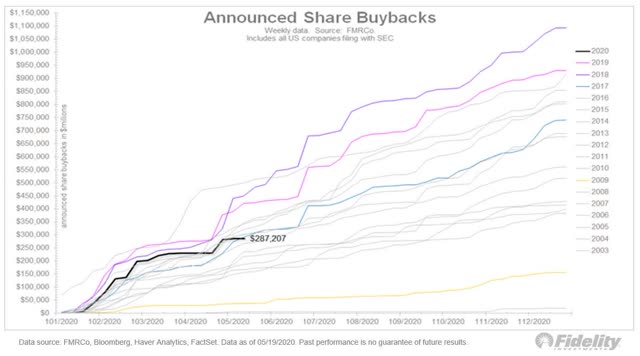
5. Big buy-backers left for dead. Buyback achievers, corporations that have reduced shares outstanding by 5% or more in the trailing 12 months, have suffered on a nominal and relative basis this year. PKW is the ETF that tracks the NASDAQ US BuyBack Achievers Index. By itself, PKW is unchanged from the middle of 2017 and barely above the December 2018 lows.
On a relative basis though, PKW has fallen to levels not seen in more than 10 years. PKW is down more than 20% YTD while the S&P 500 is down about 8%. Investors are shunning corporations who engage in heavy buybacks, perhaps counterintuitive to some market narratives.
But it also fits the thesis of the terrible perception of using liquidity in an attempt to prop up stock prices in this poor economic environment. Interestingly, PKW has a 30% weight in Financials, so that has certainly not helped the basket of stocks, but it also has a 27% position in the darling-performer within the Technology sector.
Bottom line: Businesses busy buying back their stock have not performed well this year or in the last several years. Could the next market cycle feature less in the way of share repurchase programs?
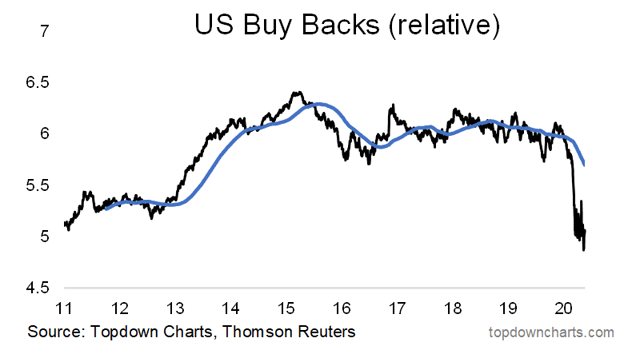
6. S&P 500 dividend yield. Keeping the theme of shareholder accretive activities, @FrankCurzio posted this chart of the ratio of the S&P 500 dividend yield over the 10-year Treasury yield (1935-present). As the denominator shrinks, the quotient skyrockets. We have written about the 10-year Treasury note yield ranging from about 55bps to 80bps in the last many weeks, far below long-term averages. Meanwhile, the S&P 500 dividend yield currently rests near or just above 2%. The result is a 3.5 multiple of the S&P 500 yield versus the current 10-year yield – the highest since the 1930s and 1940s when rates were very low and the dividend yield on the S&P was much higher. Over the decades, the yield on the S&P has come down for a number of reasons.
Another way to look at this is from the perspective of the valuation of bonds. You could argue bonds have not been this expensive in decades (or ever?). The 10-year Treasury is easily in negative territory when it comes to its after-inflation yield (or ‘real’ yield).
Bottom line: 2020 only accelerated the trend of lower interest rates (on a nominal and real basis). While the dividend yield on stocks is anything from a sure bet, its yield of 2% greatly exceeds that of Treasuries (no matter what your term).
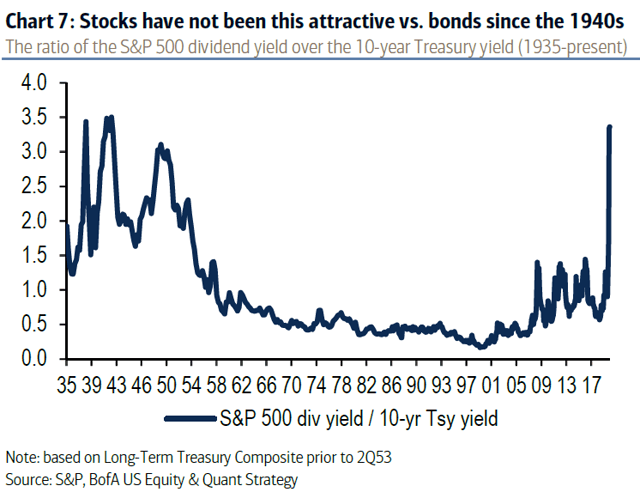
7. Lots of dividend cuts, not a lot of market cap. @westermangroup brings us this chart of dividend cuts. The data shows that while a significant number of firms are cutting their dividend, the actual percentage of market cap the cuts represent is quite small. So it is mainly the smaller companies within the index that have been reducing dividend payouts – about 10% of SPX components. It actually can make some sense if you take a step back – firms struggling to maintain liquidity are likely those with smaller market caps (less equity). Nevertheless, 2009 featured a surge in both the number of corporations slashing dividends and the market cap percentage of the cuts.
We are not even halfway home to the 2020 finish line, and it has already been the biggest year for dividend cuts since 2009 or 2010 (depending on which metric you focus on). How high will the 2020 dividend cuts go? Will we get a second wave?
Bottom line: Buybacks are under fire, dividends are being slashed, and the S&P 500 is within 10% of an all-time high. Such is life in 2020.
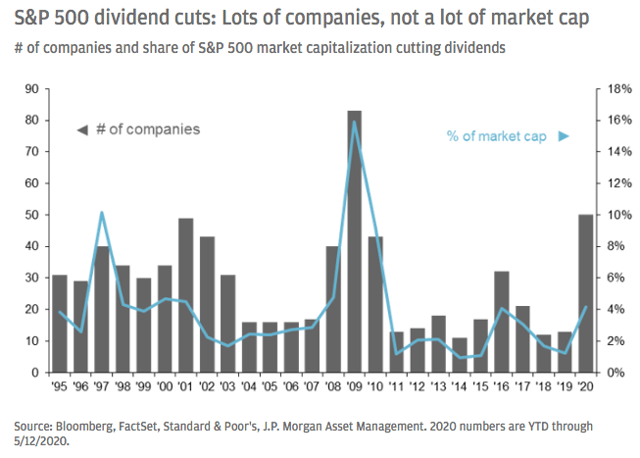
8. REITs – mixed performances. Keeping on the dividend uncertainty theme, let’s take a look at REITs. We may have been a bit dramatic last week with our “REITs in Ruins” headline since some niche real estate investment trusts are actually holding up quite well. In aggregate though, this is a space (sorry for the pun) where dividend policies will certainly be under fire. REITs are unique in that they are required to pay out 90% of profits in the form of dividends, so they often don’t have the choice to maintain a high dividend.
REITs are among the businesses that are front-and-center with regards to being negatively impacted by COVID-19 – hotels, rest homes, restaurants, malls, movie theaters – all absolutely devastated by quarantines and lockdowns. Low interest rates are typically a boon for REITs, but that current market feature is a side-note to the harsh economic reality COVID-19 has brought about. US REITs may show some relative value here, but longer-term there may be better opportunities for global investors.
Bottom line: Many yield-seeking investors look to REITs for a high stream of income return, but that has been a bad approach this year with REITs off about 20% versus an 8% decline for the S&P 500 on a total return basis.
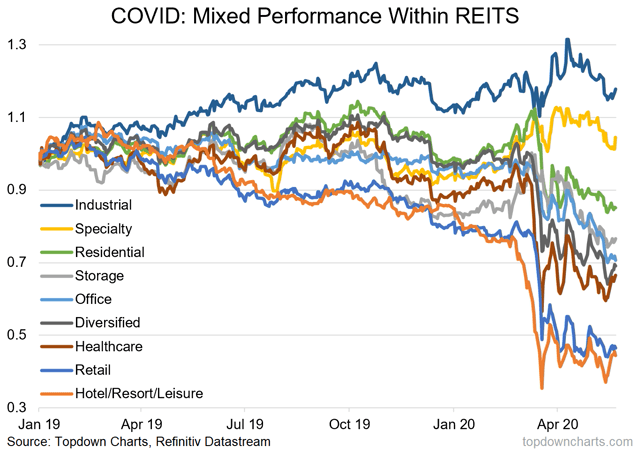
9. Financials sunset. Our countryman @haumicharts goes long term, and gives a view of financials versus the S&P 500 since 2008. On the relative chart below, a double-bottom pattern may have taken shape. Technicians also like to review momentum – momentum often turns before price, so it can be a useful indicator when attempting to identify tops and bottoms.
One of the most common momentum indicators is the 14-period RSI (relative strength index – not to be confused with a ‘relative strength’ chart). Looking short-term, the 14-day RSI on the XLF/SPY relative chart shows an uptrend while the relative price chart itself is declining. This is a bullish divergence in momentum – a good sign for financials. So that’s the ‘chart school’ take. What is the macro take?
Financials may not be left for dead. Valuations look good for the sector from a long-term point of view. With low valuations, poor sentiment, and technicals turning positive, financials could be an opportunity here.
Bottom line: the sun may have set on financials, but we are looking for a new dawn...
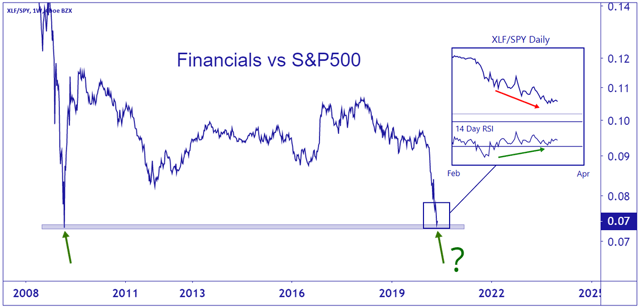
10. Going passive. @ETFResearchCtr has an update on a theme from the 2010s – the growth of index fund investing. Index funds (combining mutual funds and ETFs) represent 61% of all equity fund assets according to the latest Investment Company Institute data. The trend seems to be intact over the last several years – where and when it will level out is anyone’s wager. Falling fees and declining assets have hurt active managers in the last 10 years. It seems like ages ago when Peter Lynch and Bill Miller were the rock stars of portfolio management – now Jack Bogle is seen as being on the pedestal of long-term investing strategies.
While the growth in passive persists, zero commissions and pervasive stock-trading apps have led to an increase in retail investor stock & options trades this year as a sort of counter-trend. But that does not give any solace to mutual fund stock pickers. What’s interesting is that the late February-early April equity market volatility was yet another poor spot for active managers according to Morningstar data (77% of active equity funds lagged the S&P from 2/20/20-4/9/20).
One of the risks of passive investing is that you are still active: your strategy is to just buy the biggest companies and sell the shrinking ones. Over time, this can help automate rotating out of sunset industries and into emerging and dominant industries, but if there ends up being a sector bubble *cough - tech - cough*, you end up fully exposed.
On the flipside, the more money that flows into passive, the greater the opportunity for those willing to do the work to find the stocks that get left behind or indiscriminately pushed around by the ebb and flow of sentiment and positioning in passive equity exposure.
Bottom line: The push to passive persists, and it is not without risks & opportunities.
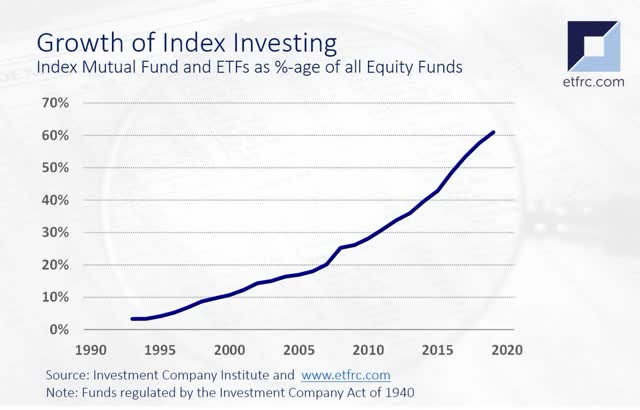
So where does all this leave us?
1. Uneasy landscape.
Earnings revisions from a significant portion of S&P 500 firms cast a shadow on the business environment. At a more granular level, companies are having a hard time making short-term debt payments, creating a potential solvency problem. Meanwhile, the US Federal Reserve has massively increased its position in Treasury securities from just a year ago in an effort to support a dismal economy. Despite stocks rising dramatically in the last two months, the landscape is not pretty. Sentiment, not surprisingly, is very weak. Investor and consumer confidence figures are in the dumps as unemployment has shot up. Cash balances in money market funds have jumped. What are stocks doing? While the last several weeks have been a rather sideways-trade, equities are still 30-35% higher from the March 23 low...
2. Total shareholder yield in flux.
Dividends and buybacks, the two components that comprise total shareholder yield, have undergone changes this year. Buybacks are down and stocks that are known as leading the charge in share repurchases have taken a huge hit to their equity prices. Dividends are also being cut, but mainly from the smaller issues within the S&P 500. Big cap tech took advantage of low rates in the last several years by issuing debt, but was also sure to hold on to a big chunk of cash for a rainy day. A result is a historically high S&P 500 dividend yield versus the 10-year Treasury rate. Areas known to pay significant dividends, REITs and the overall Financials sector, have been hit hard this year due to COVID-19 impacts. Niches within each realm offer opportunities from both a fundamental and technical stance, but risks remain.
3. Passive remains on the rise.
With so many moves in the economy and markets over the last 3 months, passive investing still appears to be gaining ground on active mutual fund managers. We are in a new environment of ‘free trades’ and everyone has a stock-trading app today. So while some are moving more passive, a new wave of stock pickers has rolled in.
Summary
Tying it all together, despite many poor economic and business trends in the last several months, stocks are near their range-highs. The S&P 500 is within 10% of its all-time peak, though small caps and industries most highly impacted by COVID-19 and economic shutdowns are still under significant pressure and haven't quite had the same recovery. Fed policy has helped keep interest rates in a rather narrow range since early April as the US Dollar ebbs from its high earlier this year. We now enter the summer period when stock tends to struggle. The bulls and bears are duking it out at the moment around the 2800-2960 range. At a guess, the odds of a selloff or some sort of short-term hiccup are high as the market struggles to clear the 200-day moving average and psychologically important 3000 level. In other words, stay the course on the long term, but wary on the short term.
Disclosure: I/we have no positions in any stocks mentioned, and no plans to initiate any positions within the next 72 hours. I wrote this article myself, and it expresses my own opinions. I am not receiving compensation for it. I have no business relationship with any company whose stock is mentioned in this article.